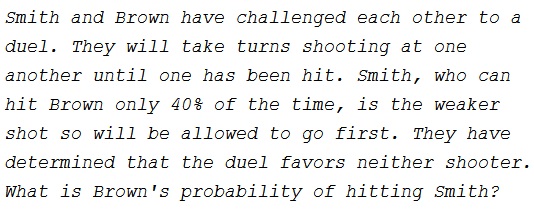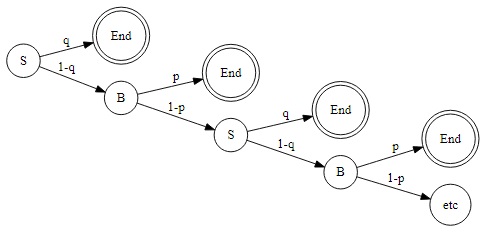Fair Duel
Problem

Solution 1 (Markov chain)
A little more general, assume Smith hits Brown with probability $q$ and Brown hits Smith with probability $p.$ There is a three state Markov chain: S(mith) shoots, B(rown) shoots, the duel End(ed).$

If $P$ is the probability of Smith winning the duel (and we know that, the duel being fair, $\displaystyle P=\frac{1}{2})$ then
$\displaystyle P=q+(1-q)(1-p)P$
which says that Smith wins on the first shot or gets an equal chance after he and Brown both miss.
This leads to $P(q+p-qp)=q,$ or $(q+p-qp)=2q,$ i.e., $\displaystyle p=\frac{q}{1-q}.$ In the specific case where $\displaystyle q=\frac{4}{10},$ $\displaystyle p=\frac{4}{6}=\frac{2}{3}.$
Solution 2 (Decision tree)
The problem can be described with a decision tree:

Equivalently,
$\begin{align} P(S~win) &= 0.4\cdot [1+0.6\cdot (1-p)+0.6^2\cdot (1-p)^2+\ldots]\\ P(B~win) &= (1-0.4)\cdot p\cdot [1+0.6(1-p)+0.6^2\cdot (1-p)^2+\ldots]\\ P(S~win) &= P(B~win) ~\Rightarrow p=\frac{0.4}{1-0.4}=\frac{2}{3}. \end{align}$
Acknowledgment
This is problem 31 from The Population Explosion and Other Mathematical Puzzles by Dick Hess (World Scientific, 2016).
Solution 2 is by Amit Itagi.
|Contact| |Front page| |Contents| |Probability|
Copyright © 1996-2018 Alexander Bogomolny73567632
